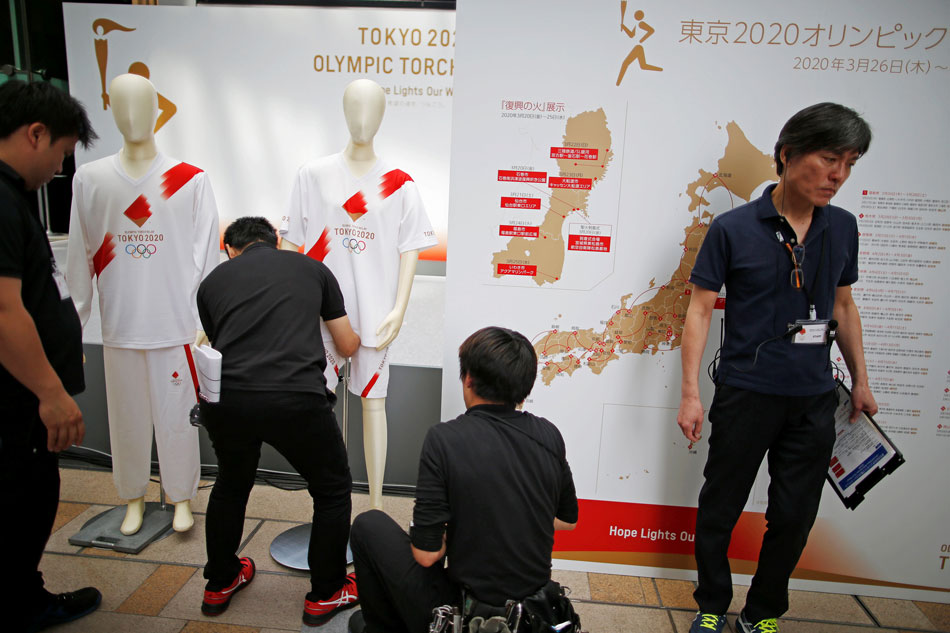Tokyo 2020 torch relay route revealed, uniforms unveiled | ABS-CBN

Welcome, Kapamilya! We use cookies to improve your browsing experience. Continuing to use this site means you agree to our use of cookies. Tell me more!
Tokyo 2020 torch relay route revealed, uniforms unveiled
Tokyo 2020 torch relay route revealed, uniforms unveiled
Jack Tarrant,
Reuters
Published Jun 01, 2019 04:41 PM PHT
TOKYO - Tokyo 2020 organizers on Saturday unveiled uniforms to be worn by 10,000 volunteer runners during the torch relay and presented further details about the route the relay will take.
TOKYO - Tokyo 2020 organizers on Saturday unveiled uniforms to be worn by 10,000 volunteer runners during the torch relay and presented further details about the route the relay will take.
Organizers said the torch will travel through all 47 of Japan's prefectures - from Hokkaido in the north to the southern island of Okinawa - and most of the country will have the chance to see the torch with 98 percent of the population residing within an hour's distance from the route.
Organizers said the torch will travel through all 47 of Japan's prefectures - from Hokkaido in the north to the southern island of Okinawa - and most of the country will have the chance to see the torch with 98 percent of the population residing within an hour's distance from the route.
The 121-day relay will begin on March 16 at the J-Village in Fukushima, which is Japanese soccer's national training center and a symbol of resilience during the 2011 earthquake and tsunami that killed almost 16,000 people.
The 121-day relay will begin on March 16 at the J-Village in Fukushima, which is Japanese soccer's national training center and a symbol of resilience during the 2011 earthquake and tsunami that killed almost 16,000 people.
Games organizers have sought to stress the importance of Tokyo 2020 as the 'reconstruction Olympics' and it was evident in the choice of the route, which will pass through Okuma, where part of the Fukushima nuclear complex is located, and past Kumamoto Castle, which suffered heavy earthquake damage in 2016.
Games organizers have sought to stress the importance of Tokyo 2020 as the 'reconstruction Olympics' and it was evident in the choice of the route, which will pass through Okuma, where part of the Fukushima nuclear complex is located, and past Kumamoto Castle, which suffered heavy earthquake damage in 2016.
ADVERTISEMENT
"It is not just about places where people can come or around landmarks, but the torch will also visit areas affected by the Great Japan Earthquake and Kumamoto Castle, recovering from the Kumamoto earthquake," said Miho Takeda, a Tokyo 2020 committee member and 5-time Olympic medalist in synchronized swimming.
"It is not just about places where people can come or around landmarks, but the torch will also visit areas affected by the Great Japan Earthquake and Kumamoto Castle, recovering from the Kumamoto earthquake," said Miho Takeda, a Tokyo 2020 committee member and 5-time Olympic medalist in synchronized swimming.
"The relay will go through areas of Japan that are working hard to recover from natural disasters."
"The relay will go through areas of Japan that are working hard to recover from natural disasters."
The torch will also visit the Hiroshima Peace Memorial Park and pass Mount Fuji before arriving at the National Stadium in Tokyo on July 24 during the Olympics opening ceremony.
The torch will also visit the Hiroshima Peace Memorial Park and pass Mount Fuji before arriving at the National Stadium in Tokyo on July 24 during the Olympics opening ceremony.
The runners' uniform, designed by fashion designer Daisuke Obana, was unveiled by multiple Olympic gold medalist judoka Tadahiro Nomura.
The runners' uniform, designed by fashion designer Daisuke Obana, was unveiled by multiple Olympic gold medalist judoka Tadahiro Nomura.
The uniforms, which are produced in part from recycled plastic bottles, incorporate a diagonally-draped red sash similar to those used as batons in Ekiden, Japan's famous long distance relay events.
The uniforms, which are produced in part from recycled plastic bottles, incorporate a diagonally-draped red sash similar to those used as batons in Ekiden, Japan's famous long distance relay events.
"The torch bearer uniform is eco-friendly. Coca-Cola collected plastic bottles in their company and recycled them to use them in the uniform material," Nomura said.
"The torch bearer uniform is eco-friendly. Coca-Cola collected plastic bottles in their company and recycled them to use them in the uniform material," Nomura said.
ADVERTISEMENT
ADVERTISEMENT


